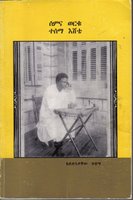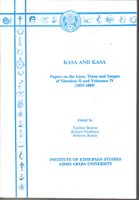
 Chronicling Negadras Tessema Eshete’s literary work, this book was published posthumously in 1992 by Ato Tadele Yidnekachew, the Negadras's grandson. Negadras Tessema Eshete’s long career in the courts of Emperor Menelik, Lij Eyasu, Empress Zewditu, and Negus Teferi Mekonnen has never been written and this book provides hundreds of Sem ena Worq (Wax and Gold) stanzas authored by the little known but immensely influential figure. Most of us know the Negadras’s son—Ato Yidnekachew Tessema (1921-1987) who played an extraordinary role in developing and popularizing sports not only in Ethiopia but also in Africa.
Chronicling Negadras Tessema Eshete’s literary work, this book was published posthumously in 1992 by Ato Tadele Yidnekachew, the Negadras's grandson. Negadras Tessema Eshete’s long career in the courts of Emperor Menelik, Lij Eyasu, Empress Zewditu, and Negus Teferi Mekonnen has never been written and this book provides hundreds of Sem ena Worq (Wax and Gold) stanzas authored by the little known but immensely influential figure. Most of us know the Negadras’s son—Ato Yidnekachew Tessema (1921-1987) who played an extraordinary role in developing and popularizing sports not only in Ethiopia but also in Africa.
(Yidnekachew Tessema’s contributions include his pioneering efforts in opening the first Ethiopian sports federation in 1943, his work in establishing the African Soccer Federation (CAF) in 1964 (he served as its deputy president between 1964-72, and as its president between 1972-87). More on Yidnekachew can be read at Ethiosports and in a recent tribute by our own Ethiopian Politics.)
Written in Amharic, Semena Worqu Tessema Eshete includes letters and communiqués written by Ethiopia’s monarchs as well as dozens of memorable photographs of the unsung poet. A few of these photographs are taken with the Negadras’s friend, Lij Eyasu, a compelling figure in Ethiopian history. (See Angelfire for an excellent summary of the young monarch's life and reign). I must admit to having struggled with some of the Sem ena Worq but most are accessible and immaculate.
---------------------------------------------------
Kassa and Kassa (Institute of Ethiopian Studies)
Published in June 1990 by the Institute of Ethiopian Studies, Kassa an d Kassa’s printing was preceded by two conferences in Addis Ababa in 1988-89 to commemorate two historic events: (1) the Battle of Meqdela and the death of Emperor Tewodros (April 13, 1868), and (2) the Battle of Metama and the death of Emperor Yohannes IV (March 9, 1889). The title Kassa and Kassa indicates the birth names of Emperors Tewodros and Yohannes—Kassa Hailu and Kassa Mersha respectively.
d Kassa’s printing was preceded by two conferences in Addis Ababa in 1988-89 to commemorate two historic events: (1) the Battle of Meqdela and the death of Emperor Tewodros (April 13, 1868), and (2) the Battle of Metama and the death of Emperor Yohannes IV (March 9, 1889). The title Kassa and Kassa indicates the birth names of Emperors Tewodros and Yohannes—Kassa Hailu and Kassa Mersha respectively.
The collection is edited by Taddese Beyene, Richard Pankhurst and Shiferaw Bekele. AAU alums should be familiar with the two Ethiopian historians and with Richard Pankhurst, the three scholars edited this resourceful treatise that features writings by the editors themselves as well as by other scholars and commentators including Sven Rubenson, Amsalu Aklilu, Seyoum Weldu, Tadesse Tamrat, Taye Assefa, Joanna Mantel-Niecko, Amanuel Sahle, Girma Kinde, Rita Pankhurst, Stephen Bell, Adhane Mengisteab, and Tesemma Ta’a.
The writings, in both Amharic and English, illustrate the roles the two Ethiopian leaders played in the formation and continuation of Ethiopia’s unification and the significance of the battles of Meqdela and Metema in Ethiopian history. Tewodros features prominently in the book which should not be a surprise given his pioneering of Ethiopia’s unification, modernization, and reform. The writings also give credit to Yohannes’s heroic fight to preserve Ethiopia’s independence against foreign invaders, including Egyptians, Mahdists, and Italian colonial incursions. Both emperors lost their lives in battle while defending their country against foreign incursions. This collection of papers is an incredible read and at times offers challenges to basic assumptions and interpretations of 19th Century Ethiopian history.
The conference on Emperor Tewodros was opened by Blaten Geta Tsegaye Gebre Medhin who spoke extempore on his famous play Tewodros and was concluded by the poet laureate’s recitation of the Emperor’s Farewell Speech from Meqdela in Tewodros. Ay Blaten Geta! What haven't you done?
----------------------------------------------------
Of What I Saw and Heard (Merse Hazen Wolde Qirqos, 2004)
This book took me by complete surprise (more on the surprise later). These are the memoirs of  Blaten Merse Hazen Wolde Qirqos, another fascinating figure in Ethiopian history. Blaten Merse Hazen, at the age of twenty became a renown Ge’ez scholar and was appointed to serve as editor of works on Biblical exegesis as well as a member of Berhanena Selam’s editorial board. He subsequently authored the official Amharic grammar before he became a court historian and high ranking government official during the reign of Haile Selassie I.
Blaten Merse Hazen Wolde Qirqos, another fascinating figure in Ethiopian history. Blaten Merse Hazen, at the age of twenty became a renown Ge’ez scholar and was appointed to serve as editor of works on Biblical exegesis as well as a member of Berhanena Selam’s editorial board. He subsequently authored the official Amharic grammar before he became a court historian and high ranking government official during the reign of Haile Selassie I.
I first read about Blaten Merse Hazen in a recent book I read by Ambassador Zewde Reta, Teferi Mekonnen, Rejimu Yeseltan Guzo beMinilik, beIyassu ena beZewditu Zemen (1884-1922) (Tafari Makonnen: The Long Journey to Power during the Reigns of Menelik, Eyasu and Zewditu, 1884-1922) who quotes extensively from Merse Hazen’s memoirs. Of What I Saw and Heard recounts events that took place when the author was barely fourteen years old while he lived in Emperor Menelik’s and Lij Eyasu's courts. The entries provide a fascinating account of the young boy’s observation of several events including the arrival of the steam roller in 1903 (and Menelik’s observation of the test drive and subsequent ride in it), the building of the Entoto road, the construction of Entoto Mariam Church; the planting of eucalyptus trees in Addis Ababa, Ras Mekonnen’s death, the opening of a language school, the appointment of judges, the emperor’s illness, his proclamation of Eyasu’s rule, “the conspiracy of the mehal sefari” (against Empress Taitu), the transition of power to Eyasu, the secrecy surrounding Menelik’s death, the coronation of Negus Michael as King, the start of the European war (WWI), Eyasu’s support of the German policy, Teferi Mekonnen’s arrival, his near drowning in Lake Haremaya, the rumors about Eyasu’s alleged efforts to convert Ethiopia to Islam, and the conspiracy and subsequent coup.
So why the surprise? Apparently, the editors who published this memoir, including Gerard Prunier, Director of the French Center for Ethiopian Studies, are being sued by Blaten Merse Hazen’s son for copyright infringement. The following exerpt from an interview with Prunier was posted on Hararis, a Canadian based Ethiopian website:
Q: What does your centre concentrate on at present?
A: The main thing that we are trying to do is human geography and trying to revive a certain tradition of modern and contemporary history, which used to exist and which is now falling a little bit behind. We have done the memories of Mersae Hazen Wold-Kirkos and now we are being sued by the son of Mersae Hazen Wolde-Kirkos who says that we stole the manuscript that belongs to him. Mersae Hazen wrote a manuscript on his life between the times he was at the palace during the last years of Emperor Menelik till the coronation of Ras Tafari Makonnen (Emperor Haile-Selassie) in 1930. And this was never published. The manuscript of these memories was given to us by Prof. Bahru Zewde when he was director of the Institute of Ethiopian Studies for the purpose of translation and publication which we did. And now we are sued by the son of Mersae Hazen who lives in the United States. He says that this theft of intellectual property. But we believe that this is wrong because we found his manuscripts in public libraries. And no copyright has been deposed on them. And secondly, the Ethiopian law is silent about manuscripts. But on published works where there is an automatic copyright, you could say the time limit is fifty years. And this manuscript was written 62 years ago. It was written during World War II. When Mersae Hazen Wolde-Kirkos was living in exile at the convent of the Ethiopian Monks in Jerusalem. And he never published it because he had his difficulties with the Emperor. Later in life, he became the president of the Parliament. But he was very careful with the Emperor, because when he was a young man, he was not among those who supported Ras Tafari Makonnen. And so, he never published his memories. This is why the manuscript has been floating around like this for a long time. We published an English translation of Mersae’s memories. We also published two biographies of two sultan of Afar, Mohammed al-Fareh, who died in 1902 or 1903 and Ali Mirah, who is still alive, a very old man.
Hmm. My brief research on intellectual property law only helped me understand its circuitous complexities but Prunier’s arguments don’t seem to make much sense. Prunier et al., if you published it without authority, pay up. Arguments such as “[w]e found his manuscript in public libraries” and “Ethiopian law is silent about manuscripts” don't seem to hold much water and I am curious to know if anything happened to the copyright claim.
- Lela Tensae-ETA Moonlight's Mock HR5860 Response Letter from Dennis Hastert is hillarious and brilliantly written (Afrigro is a great term);
- Shadows' A Father's Perspective is brilliant;
- Like the Wonq, we find Tsegasaurus' silence disconcerting;
- Enset's Skepticism and delusion, shunning from reality is AWESOME, AWESOME, AWESOME. Consider Ephrem's concluding paragraph:
The key to building a free society lies in creating a durable set of democratic institutions - some public, some private - that encourage "Representative Democracy" as well as economic openness for long periods of time. This historic responsibility is not the task of few people; it is not even a task to be completed by one generation. Our grandfathers/mothers made us proud Africans by breaking the backbone of Italian colonialism. Our fathers/mothers lived in the darkness of the two [feudal, military] consecutive authoritarian regimes, but they educated us and enabled us to perceive the anatomy of evil. Dealing with the forces of evil is the responsibility of this generation. Our children should be left to focus on agriculture, medicine, economics, and engineering. I usually take my son to G. Washington, T. Jefferson, A. Lincoln, and FDR memorials, and take myself back in time to give respect to what these heroes did to their country. Our country Ethiopia needs heroes like Jefferson and Lincoln who burn like a candle to give light to others. When he gets old, I hope, my son takes his children to memorials, but to a different memorial; to a memorial of champion Ethiopians!
